
Surveillance
Dell EMC Storage with ISS SecurOS
Sizing Guide
H14192
REV 1.1

Copyright
©
2015-2017 Dell Inc. or its subsidiaries. All rights reserved.
Published June 2015
Dell believes the information in this publication is accurate as of its publication date. The information is subject to change without notice.
THE INFORMATION IN THIS PUBLICATION IS PROVIDED “AS-IS.“ DELL MAKES NO REPRESENTATIONS OR WARRANTIES OF ANY KIND
WITH RESPECT TO THE INFORMATION IN THIS PUBLICATION, AND SPECIFICALLY DISCLAIMS IMPLIED WARRANTIES OF
MERCHANTABILITY OR FITNESS FOR A PARTICULAR PURPOSE. USE, COPYING, AND DISTRIBUTION OF ANY DELL SOFTWARE DESCRIBED
IN THIS PUBLICATION REQUIRES AN APPLICABLE SOFTWARE LICENSE.
Dell, EMC, and other trademarks are trademarks of Dell Inc. or its subsidiaries. Other trademarks may be the property of their respective owners.
Published in the USA.
Dell EMC
Hopkinton, Massachusetts 01748-9103
1-508-435-1000 In North America 1-866-464-7381
www.DellEMC.com
2 Dell EMC Storage with ISS SecurOS Sizing Guide

Introduction 5
Solution overview......................................................................................... 6
Scope........................................................................................................... 6
Key objectives.............................................................................................. 7
Configured components 9
Isilon clustered storage system................................................................... 10
Data protection........................................................................................... 10
Isilon protection with OneFS.......................................................... 10
Cluster size..................................................................................................11
Solution components 13
Dell EMC storage........................................................................................ 14
Storage protocols....................................................................................... 14
ISS SecurOS Enterprise.............................................................................. 14
Sizing the solution 17
Bandwidth sizing guidelines.........................................................................18
EMC VNX ...................................................................................................18
Dell EMC Isilon node and cluster (SMB2)....................................................19
Testing and validation 21
Test objectives........................................................................................... 22
Test parameters......................................................................................... 22
Tests conducted.........................................................................................22
Conclusion 25
Summary.................................................................................................... 26
Dell EMC Isilon scale-out storage.................................................. 26
EMC VNX arrays........................................................................... 26
EMC VNX-VSS arrays................................................................... 26
Chapter 1
Chapter 2
Chapter 3
Chapter 4
Chapter 5
Chapter 6
CONTENTS
Dell EMC Storage with ISS SecurOS Sizing Guide 3

CONTENTS
4 Dell EMC Storage with ISS SecurOS Sizing Guide

CHAPTER 1
Introduction
This chapter provides information on the purpose and scope of this solution:
l
Solution overview.................................................................................................6
l
Scope...................................................................................................................6
l
Key objectives...................................................................................................... 7
Introduction 5

Solution overview
The purpose of this guide is to help you understand the benefits of using a Dell EMC
storage solution with ISS SecurOS. The solution includes both hardware and software
elements for video surveillance.
The storage platforms include physical hosts that are running SecurOS Enterprise
Video Surveillance Manager.
Scope
This guide is intended for use by internal Dell EMC sales and pre-sales personnel, and
qualified Dell EMC and ISS partners.
The guidelines presented are for storage platform positioning and system sizing. The
sizing recommendations are based on performance and storage protocol conclusions
derived from Dell EMC testing.
The guidelines for sizing this video storage solution describe the use of the following
storage platforms:
l
Dell EMC Isilon
™
l
EMC VNX
™
These guidelines include the following design considerations:
l
Architectural overview of ISS SecurOS
l
Dell EMC storage considerations for ISS SecurOS
l
Result summaries for the tests carried out by Dell EMC engineers in a VMware
ESXi virtualized infrastructure
Use this guide to determine the best configuration for the following:
l
Number of ISS Video Servers
l
Mix of nodes and ISS Video Servers based on the expected bandwidth in an Isilon
implementation
l
Storage using Fibre Channel (FC) and Internet SCSI (iSCSI) on VNX systems
l
Storage using Server Message Block (SMB) on Isilon systems
l
Load factors related to the use of Dell EMC storage arrays in the customer's
solution
Note
All performance data contained in this report was obtained in a rigorously controlled
environment. Network topology and system environment variables can have
significant impact on performance and stability. Follow the best practices as outlined
in the
Dell EMC Storage with ISS SecurOS: Configuration Guide
regarding network and
storage array configuration. Server and network hardware can also affect
performance. Performance varies depending on the specific hardware and software,
and might be different from what is outlined here. Performance results will be similar if
your environment uses similar hardware and network topology.
Introduction
6 Dell EMC Storage with ISS SecurOS Sizing Guide

Key objectives
The configurations documented in this guide are based on tests conducted in the Dell
EMC Surveillance Lab and actual production implementations.
These are the key objectives of this solution:
l
Measure the sizing needs for specific system requirements so that an
implementation can be correctly sized and the appropriate Dell EMC products can
be matched to a customer's requirements.
l
Determine the VNX and VSS LUN bandwidth within the storage pool.
l
Recommend an Isilon SMB configuration.
l
Calculate array or node maximum bandwidths.
l
Recommend disk drive types.
l
Determine Isilon bandwidth for each ISS Video Server
Introduction
Key objectives 7

Introduction
8 Dell EMC Storage with ISS SecurOS Sizing Guide

CHAPTER 2
Configured components
This chapter provides information about the components configured in this solution:
l
Isilon clustered storage system...........................................................................10
l
Data protection...................................................................................................10
l
Cluster size......................................................................................................... 11
Configured components 9

Isilon clustered storage system
Isilon NAS was designed and developed specifically for storing, managing, and
accessing digital content and other unstructured data.
An Isilon clustered storage system is composed of three or more nodes. Each node is a
self-contained, rack-mountable device that contains industry-standard hardware such
as disk drives, CPUs, memory, and network interfaces. These nodes are integrated
with the proprietary Isilon OneFS
™
operating system, which is a distributed networked
file system that unifies a cluster of nodes into a single shared resource.
Network interface card (NIC) aggregation can be used to reduce the possibility of
video loss from a cable pull, NIC failure, or switch port issue. Dell EMC recommends
NIC aggregation, also known as link aggregation, in an active/passive failover
configuration. This method transmits all data through the master port, which is the
first port in the aggregated link. If the master port is unavailable, the next active port
in an aggregated link takes over.
Data protection
OneFS does not rely on hardware-based RAID for data protection. The Isilon system
uses the Reed-Solomon algorithm for N+M protection with Forward Error Correction
(FEC).
Protection is applied at the file level, enabling the cluster to recover data quickly and
efficiently. Nodes, directories, and other metadata are protected at the same or a
higher level as the data blocks they reference. Since all data, metadata, and FEC
blocks are spread across multiple nodes, dedicated parity drives are not required. For
more information about Isilon data protection, see
Dell EMC Isilon OneFS: A Technical
Overview
.
Although cluster sizes as small as three nodes are possible, for surveillance
applications we recommend a minimum of five nodes. Sizing calculations need to
include a minimum free space calculation for proper cluster sizing. We recommend a
cluster size that enables a node to be removed while retaining a minimum of 10
percent free space in the remaining capacity. This cluster size ensures that node
removal and node failures have minimal or no impact on video ingestion.
The Isilon sizing tool provides an accurate calculation. You can find this tool at
https://isilon-sizing-tool.herokuapp.com. Other sizing tools from video management
software (VMS) and camera vendors may also be used for sizing the necessary
bandwidth and storage capacity.
During our testing, we discovered that there might be some video loss when adding or
removing a node from the cluster. Isilon OneFS is a scale-out, single namespace,
clustered file system. To maintain coherency, OneFS implements a distributed lock
manager that marshals locks across all nodes in the cluster. When a node is added to
or removed from the cluster, all operations must be temporarily suspended until all
existing locks are rebalanced across the resulting node set. The system must then
recalculate the cluster write plan. The time that is required for this group change to
occur depends on the size of the cluster, individual node performance, and the cluster
workload.
Isilon protection with OneFS
New or upgraded clusters, starting with OneFS 7.2, provide a data protection level
that meets Dell EMC Isilon guidelines for mean time to data loss (MTTDL) for large
Configured components
10 Dell EMC Storage with ISS SecurOS Sizing Guide

capacity nodes. Current releases of OneFS offer a new protection option, +3d:1n1d,
which means the cluster can survive three simultaneous disk failures or one entire
node failure plus one disk. OneFS also provides an option that continually evaluates
the cluster and sends an alert if the cluster falls below the suggested protection level.
Cluster size
We recommend a minimum cluster size of five nodes, even if you are not writing to all
of them. For example, if you are implementing a four-node Video Server solution,
implement a five-node cluster. This also meets the recommended best practices for
data protection.
To estimate the ideal number of nodes in a cluster, you need to consider cluster
bandwidth and capacity.
Sizing by bandwidth
We recommend a cluster size with one or more additional nodes than calculated in
bandwidth sizing. This ensures that failover of a node allows for redistribution of
NAS connections and avoids any frame loss.
Sizing by aggregate capacity
We recommend a cluster size with enough usable capacity to handle 110 percent
of the calculated space requirement, with a minimum added capacity of one full
node plus 10 percent. The values are based on camera bit rate.
The Isilon sizing tool can use both the sizing by bandwidth and sizing by aggregate
capacity methods when calculating ideal cluster size.
Configured components
Cluster size 11

Configured components
12 Dell EMC Storage with ISS SecurOS Sizing Guide

CHAPTER 3
Solution components
This chapter provides information about storage options for video and audio data:
l
Dell EMC storage................................................................................................14
l
Storage protocols............................................................................................... 14
l
ISS SecurOS Enterprise......................................................................................14
Solution components 13

Dell EMC storage
Dell EMC storage arrays are ideal for storing video and audio data.
This guide describes the tests for the following storage arrays:
l
Isilon clusters
l
VNX arrays
For our testing, we used both single and dual storage processors for the full range of
VNX storage arrays and single- and multi-node performance testing on the Isilon
storage array.
Storage protocols
Dell EMC uses standard file protocols to enable users and applications to access data
that is consolidated on a Dell EMC storage solution.
This guide provides information about these network protocols:
l
FC
l
iSCSI
l
SMB (CIFS)
ISS SecurOS Enterprise
An ISS SecurOS Enterprise installation can consist of a single video server or multiple
servers in a hierarchical structure. You can configure SecurOS to manage a few
cameras or thousands of cameras.
The following table describes three primary SecurOS services.
Table 1
SecurOS primary services
Service Description
ISS SecurOS Video
Server
The Video Server is a computer that is used to connect cameras (IP
and/or CCTV analog cameras), from which to receive video. In
addition to cameras, this installation type enables the installation or
connection of various security devices (fire alarm system controllers,
access control subsystem controllers, among others) and ISS
analytics modules (for example, SecurOS Auto Module). The Video
Server installation also includes all the functionalities of the
Administrator Workstation and Operator Workstation installation
types.
ISS SecurOS
Operator Workstation
The Operator Workstation is a client computer in the security network
designed for remote viewing of video from surveillance cameras,
listening to audio, and managing various devices such as PTZ devices,
doors, fire alarms and other subsystems.
ISS SecurOS
Administrator
Workstation
The Administrator Workstation is a client computer similar to the
Operator Workstation but with an additional administrator interface
for configuring the security network. From the Administrator
Workstation you can perform the following administrator operations:
Solution components
14 Dell EMC Storage with ISS SecurOS Sizing Guide

Table 1 SecurOS primary services (continued)
Service Description
l
Create and configure system objects
l
Delete existing objects
l
Change the parameters of the created and operating objects
Solution components
ISS SecurOS Enterprise 15

Solution components
16 Dell EMC Storage with ISS SecurOS Sizing Guide

CHAPTER 4
Sizing the solution
This chapter provides information to enable you to quickly determine the correct
storage array based on your customer's bandwidth requirements:
l
Bandwidth sizing guidelines................................................................................ 18
l
EMC VNX .......................................................................................................... 18
l
Dell EMC Isilon node and cluster (SMB2)........................................................... 19
Sizing the solution 17

Bandwidth sizing guidelines
All solution tests were performed in a lab environment. The storage system, cameras,
and VLANs in the lab environment were dedicated to these tests.
Connections to the storage system under test conditions were restricted to SecurOS
Video Server, monitoring, and web management stations. Expect some variance
between the lab results and a production environment.
EMC VNX
We conducted validation tests to determine how ISS works with VNX storage arrays.
The test results shown in the following table are based on a conservative model to
ensure that the constant-bandwidth video traffic is unaffected during a single storage
pool (SP) maintenance cycle, disk rebuild, or similar performance-intensive events.
The VNX 5300 and VNX-VSS100 can exceed 500 MB/s in an environment without
induced errors.
Table 2 EMC VNX/VNXe storage array results
Storage
Protocol
Array Bandwidth
(MB/s)
Storage Pools RAID
Array/
Pool
LUN Pools LUNs/
Pool
Disks/
Pool
iSCSI VNX5300 60 60 1 1 72 5
VNX-
VSS100
60 60 1 1 72 5
VNX5200 60 60 1 1 81 5
300* 30 1 5 81 5
* This bandwidth is the maximum tested per SP on the VNX system and not the array
maximum
Note
All disks are NL-SAS, 4 TB 7200 RPM drives unless otherwise stated.
The following table lists the firmware builds used in these tests. Expect equal or better
results if you use more recent firmware or newer models of VNX storage.
Table 3
EMC VNX firmware builds
Array Firmware
VNX5300 VNX OE 5.32.000.5.206
VNX5200 VNX OE 5.33.000.5.035
Sizing the solution
18 Dell EMC Storage with ISS SecurOS Sizing Guide

Dell EMC Isilon node and cluster (SMB2)
The test results are based on a model in which the constant-bandwidth surveillance
video traffic remained unaffected during a single node maintenance cycle, disk rebuild,
SP failure, or non-disruptive upgrade.
We used 10 Gigabit Ethernet (10 GbE) interfaces with no more than four SMB
connections per interface. A 1 GbE interface can accommodate up to a single Video
Server connection at the maximum ISS SecurOS-supported values.
We performed all tests with a per-camera bandwidth of 7 Mb/s, so a single Video
Server that handles 65 MB/s can support 75 such cameras. If the planned deployment
requires many more cameras per Video Server, for example 200 low-resolution
cameras, the numbers in the following table are valid with a high confidence level for
bandwidth performance for up to 2,000 cameras.
We performed all tests with node or drive failures in place in the cluster (for example,
with Isilon FlexProtect
™
running) to ensure a worst-case scenario for all sizing
parameters.
The following table provides bandwidth-sizing guidelines based on our test results.
Table 4 Dell EMC Isilon node and cluster (SMB) test results
Clust
er
OneF
S
versi
on
Video
Serve
rs per
node
Bandwidth (MB/s) Clust
er
size
Node
s
writt
en
Disk Drives
Total
clust
er
Per
node
Per
host
Size Type RPM
X410 7.2.0.0 1 63.3 63.3 63 4 1 4 TB SATA 7,200
X410 7.2.0.0 2 128 128 64 4 1 4 TB SATA 7,200
X410 7.2.0.0 4 256 256 64 4 1 4 TB SATA 7,200
X410 7.2.0.0 3 386 193 64 4 2 4 TB SATA 7,200
Sizing the solution
Dell EMC Isilon node and cluster (SMB2) 19

Sizing the solution
20 Dell EMC Storage with ISS SecurOS Sizing Guide
Page is loading ...
Page is loading ...
Page is loading ...
Page is loading ...
Page is loading ...
Page is loading ...
-
 1
1
-
 2
2
-
 3
3
-
 4
4
-
 5
5
-
 6
6
-
 7
7
-
 8
8
-
 9
9
-
 10
10
-
 11
11
-
 12
12
-
 13
13
-
 14
14
-
 15
15
-
 16
16
-
 17
17
-
 18
18
-
 19
19
-
 20
20
-
 21
21
-
 22
22
-
 23
23
-
 24
24
-
 25
25
-
 26
26
Dell EMC VNX-VSS100 Server Sizing Manual
- Type
- Server Sizing Manual
- This manual is also suitable for
Ask a question and I''ll find the answer in the document
Finding information in a document is now easier with AI
Related papers
-
Dell PowerSwitch S4048-ON User guide
-
Dell High Performance Computing Solution Resources Owner's manual
-
Dell High Performance Computing Solution Resources Owner's manual
-
Dell High Performance Computing Solution Resources Owner's manual
-
Dell High Performance Computing Solution Resources Owner's manual
-
Dell High Performance Computing Solution Resources Owner's manual
-
Dell High Performance Computing Solution Resources Owner's manual
-
Dell Security Solution Resources Owner's manual
-
Dell High Performance Computing Solution Resources Owner's manual
-
Dell High Performance Computing Solution Resources Owner's manual
Other documents
-
JVC VR-N100U User manual
-
ATTO Technology ThunderLink Configuration manual
-
inVENTer MZ-Home Installation guide
-
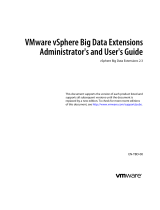 VMware vSphere vSphere Big Data Extensions 2.3 User guide
VMware vSphere vSphere Big Data Extensions 2.3 User guide
-
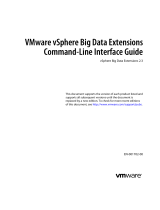 VMware vSphere vSphere Big Data Extensions 2.3 User guide
VMware vSphere vSphere Big Data Extensions 2.3 User guide
-
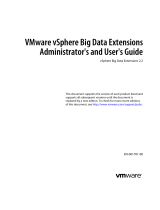 VMware vSphere vSphere Big Data Extensions 2.2 User guide
VMware vSphere vSphere Big Data Extensions 2.2 User guide
-
inVENTer MZ-Home Operating instructions
-
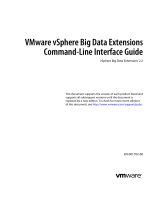 VMware vSphere vSphere Big Data Extensions 2.2 User guide
VMware vSphere vSphere Big Data Extensions 2.2 User guide
-
ESET Server Security for Linux (File Security) 8 Owner's manual
-
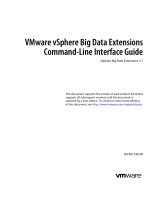 VMware vSphere vSphere Big Data Extensions 2.1 User guide
VMware vSphere vSphere Big Data Extensions 2.1 User guide






























